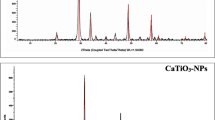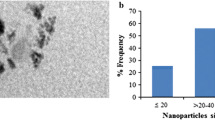Abstract
Nickel nanoparticles (NiNPs) are increasingly used in various applications due to their unique properties. However, there is little information concerning the toxicity of NiNPs in the human skin cell (A431). The present study was designed to investigate the cytotoxicity, apoptosis, and DNA damage due to NiNPs in A431 cells. A cellular proliferative capacity test showed that NiNPs induce significant cytotoxicity in a dose- and time-dependent manner. NiNPs were also found to induce oxidative stress evidenced by the generation of reactive oxygen species (ROS) and depletion of glutathione (GSH). Further, co-treatment with the antioxidant N-acetylcysteine (NAC) mitigated the ROS generation due to NiNPs, suggesting the potential mechanism of oxidative stress. NiNPs also induced significant elevation of lipid peroxidation, catalase, and superoxide dismutase and caspase-3 activity in A431 cells. In addition, NAC suppressed NiNP-induced caspase-3 activity. DNA fragmentation analysis using the comet assay showed that the NiNPs cause genotoxicity in a dose- and time-dependent manner. Therefore, the study points out the capability of the NiNPs to induce oxidative stress resulting in apoptosis and genotoxicity. This study warrants more careful assessment of NiNPs before their industrial applications.







Similar content being viewed by others
References
Bataille V (2004) Genetic factors in nickel allergy. Journal of Investigative Dermatology 123, xxiv–xxv. doi:10.1111/j.0022-202X.2004.23508.x
Vemula PK, Anderson RR, Karp JM (2011) Nanoparticles reduce nickel allergy by capturing metal ions. Nat Nanotechnol 6:291–295
Zhao J, Wang ZY, Liu XY, Xie XY, Zhang K, Xing B (2011) Distribution of CuO nanoparticles in juvenile carp (Cyprinus carpio) and their potential toxicity. J Hazard Mater 197:304–310
Guo D, Wu C, Li X, Jiang H, Wang X, Chen B (2008) In vitro cellular uptake and cytotoxic effect of functionalized nickel nanoparticles on leukemia cancer cells. J Nanosci Nanotechnol 8:2301–2307
Singh N, Manshian B, Jenkins GJ, Griffiths SM, Williams PM, Maffeis TG, Wright CJ, Doak SH (2009) Nanogenotoxicology: the DNA damaging potential of engineered nanomaterials. Biomater 30:3891–3914
Skocaj M, Filipic M, Petkovic J, Novak S (2011) Titanium dioxide in our everyday life; is it safe? Radiol Oncol 45:227–247
Li Y-F, Chen C (2011) Fate and toxicity of metallic and metal-containing nanoparticles for biomedical applications. Small 7:2965–2980
Ostrovsky S, Kazimirsky G, Gedanken A, Brodie C (2009) Selective cytotoxic effect of ZnO nanoparticles on glioma cells. Nano Res 2:882–890
Nel A, Xia T, Madler L, Li N (2006) Toxic potential of materials at the nano-level. Science 311:622–627
Wang Y, Aker WG, Hwang HM, Yedjou CG, Yu H et al (2011) A study of the mechanism of in vitro cytotoxicity of metal oxide nanoparticles using catfish primary hepatocytes and human HepG2 cells. Sci Total Environ 409:4753–4762
Murdock RC, Braydich-Stolle L, Schrand AM, Schlager JJ, Hussain SM (2007) Characterization of nanomaterial dispersion in solution prior to in vitro exposure using dynamic light scattering technique. Toxicol Sci 101:239–253
Mossman T (1983) Rapid colorimetric assay for cellular growth and survival: application to proliferation and cytotoxicity assays. J. Immunol Meth 65:55–63
Wroblewski F, LaDue JS (1955) Lactate dehydrogenase activity in blood. Prop Soc Exp Biol Med 90:210–213
Wang H, Joseph JA (1999) Quantifying cellular oxidative stress by dichlorofluorescein assay using microplate reader. Free Radic Biol Med 27:612–616
Bradford MM (1976) A rapid and sensitive method for the quantitation of microgram quantities of protein utilizing the principle of protein-dye binding. Anal Biochem 72:248–254
Ohkawa H, Ohishi N, Yagi K (1979) Assay for lipid peroxides in animal tissues by thiobarbituric acid reaction. Anal Biochem 95:351–358
Ellman G (1959) Tissue sulfhydryl groups. Arch. Biochem Biophys 82:70–77
Kakkar PS, Das B, Viswanathan PN (1984) A modified spectrophotometric assay of superoxide dismutase. Ind J Biochem Biophys 21:130–132
Sinha AK (1972) Colorimetric assay of catalase. Anal Biochem 47:389–394
Guan T, Qin F, Du J, Geng L, Zhang Y, Li M (2007) AICAR inhibits proliferation and induced S-phase arrest and promotes apoptosis in CaSki cells. Acta Pharm Sinica 28:1984–1990
Singh NP, McCoy MT, Tice RR, Schneider EL (1988) A simple technique for quantization of low levels of DNA damage in individual cells. Exp Cell Res 175:184–191
Ali D, Ray RS, Hans RK (2010) UVA-induced cyototoxicity and DNA damaging potential of benz (e) acephenanthrylene in human skin cell line. Toxicol Lett 199(2):193–200
Anderson D, Yu TW, Phillips BJ, Schmerzer P (1994) The effect of various antioxidants and other modifying agents on oxygen-radical generated DNA damage inhuman lymphocytes in the comet assay. Mutat Res 307:261–271
Monteiro-Riviere NA, Inman AO, Zhang LW (2009) Limitations and relative utility of screening assays to assess engineered nanoparticle toxicity in a human cell line. Toxicol Appl Pharmacol 234(2):222–235
Xia T, Kovochich M, Brant J, Hotze M, Sempf J, Oberley T, Sioutas C, Yeh JI, Wiesner MR, Nel AE (2006) Comparison of the abilities of ambient and manufactured nanoparticles to induce cellular toxicity according to an oxidative stress paradigm. Nano Lett 6(8):1794–1807
Ott M, Gogvadze V, Orrenius S, Zhivotovsky B (2007) Mitochondria, oxidative stress and cell death. Apoptosis 12:913–922
Rana SV (2008) Metals and apoptosis: recent developments. J Trace Elem Med Biol 22:262–284
Kang SJ, Kim BM, Lee YJ, Hong SH, Chung HW (2009) Titanium dioxide nanoparticles induce apoptosis through the JNK/p38-caspase-8-Bid pathway in phytohemagglutinin-stimulated human lymphocytes. Biochem Biophys Res Commun 386:682–687
Eom HJ, Choi J (2009) Oxidative stress of CeO2 nanoparticles via p38-Nrf-2 signaling pathway in human bronchial epithelial cell, BEAS-2B. Toxicol Lett 187:77–83
Ispas C, Andreescu D, Patel A, Goia DV, Andreescu S, Wallace KN (2009) Toxicity and developmental defects of different sizes and shape nickel nanoparticles in zebrafish. Environ Sci Technol 43(16):6349–6356
Chen M, Mikecz A (2005) Formation of nucleoplasmic protein aggregates impairs nuclear function in response to SiO2 nanoparticles. Exp Cell Res 305(1):51–62
Collins AR (2004) The comet assay for DNA damage and repair: principles, applications, and limitations. Mol Biotech 26(3):249–261
Martinez GR, Loureiro AP, Marques SA, Miyamoto S, Yamaguchi LF, Onuki J et al (2003) Oxidative and alkylating damage in DNA. Mutat Res 544(2–3):115–127
Acknowledgment
The authors would like to extend their sincere appreciation to the Deanship of Scientific Research at King Saud University for its funding of this research through the research group project no. RGP-VPP-180.
Conflict of Interest
The authors declare no conflicting interests.
Author information
Authors and Affiliations
Corresponding author
Additional information
Daoud Ali and Saud Alarifi contributed equally to this work.
Rights and permissions
About this article
Cite this article
Alarifi, S., Ali, D., Alakhtani, S. et al. Reactive Oxygen Species-Mediated DNA Damage and Apoptosis in Human Skin Epidermal Cells After Exposure to Nickel Nanoparticles. Biol Trace Elem Res 157, 84–93 (2014). https://doi.org/10.1007/s12011-013-9871-9
Received:
Accepted:
Published:
Issue Date:
DOI: https://doi.org/10.1007/s12011-013-9871-9




